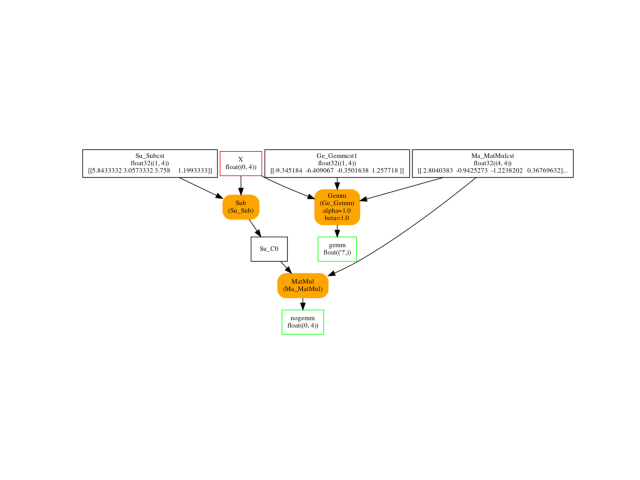Note
Click here to download the full example code
Change the number of outputs by adding a parser¶
By default, sklearn-onnx assumes that a classifier has two outputs (label and probabilities), a regressor has one output (prediction), a transform has one output (the transformed data). What if it is not the case? The following example creates a custom converter and a custom parser which defines the number of outputs expected by the converted model.
Example A new converter with options shows a converter which selects two ways to compute the same outputs. In this one, the converter produces both. That would not be a very efficient converter but that’s just for the sake of using a parser. By default, a transformer only returns one output but both are needed.
A new transformer¶
from pyquickhelper.helpgen.graphviz_helper import plot_graphviz
from mlprodict.onnxrt import OnnxInference
import numpy
from onnxruntime import InferenceSession
from sklearn.base import TransformerMixin, BaseEstimator
from sklearn.datasets import load_iris
from skl2onnx import update_registered_converter
from skl2onnx.common.data_types import guess_numpy_type
from skl2onnx.algebra.onnx_ops import (
OnnxSub, OnnxMatMul, OnnxGemm)
from skl2onnx import to_onnx, get_model_alias
class DecorrelateTransformer(TransformerMixin, BaseEstimator):
"""
Decorrelates correlated gaussian features.
:param alpha: avoids non inversible matrices
by adding *alpha* identity matrix
*Attributes*
* `self.mean_`: average
* `self.coef_`: square root of the coveriance matrix
"""
def __init__(self, alpha=0.):
BaseEstimator.__init__(self)
TransformerMixin.__init__(self)
self.alpha = alpha
def fit(self, X, y=None, sample_weights=None):
if sample_weights is not None:
raise NotImplementedError(
"sample_weights != None is not implemented.")
self.mean_ = numpy.mean(X, axis=0, keepdims=True)
X = X - self.mean_
V = X.T @ X / X.shape[0]
if self.alpha != 0:
V += numpy.identity(V.shape[0]) * self.alpha
L, P = numpy.linalg.eig(V)
Linv = L ** (-0.5)
diag = numpy.diag(Linv)
root = P @ diag @ P.transpose()
self.coef_ = root
return self
def transform(self, X):
return (X - self.mean_) @ self.coef_
data = load_iris()
X = data.data
dec = DecorrelateTransformer()
dec.fit(X)
pred = dec.transform(X[:5])
print(pred)
Out:
[[ 0.0167562 0.52111756 -1.24946737 -0.56194325]
[-0.0727878 -0.80853732 -1.43841018 -0.37441392]
[-0.69971891 -0.09950908 -1.2138161 -0.3499275 ]
[-1.13063404 -0.13540568 -0.79087008 -0.73938966]
[-0.35790036 0.91900236 -1.04034399 -0.6509266 ]]
Conversion into ONNX with two outputs¶
Let’s try to convert it and see what happens.
def decorrelate_transformer_shape_calculator(operator):
op = operator.raw_operator
input_type = operator.inputs[0].type.__class__
input_dim = operator.inputs[0].type.shape[0]
output_type = input_type([input_dim, op.coef_.shape[1]])
operator.outputs[0].type = output_type
def decorrelate_transformer_converter(scope, operator, container):
op = operator.raw_operator
opv = container.target_opset
out = operator.outputs
X = operator.inputs[0]
dtype = guess_numpy_type(X.type)
Y1 = OnnxMatMul(
OnnxSub(X, op.mean_.astype(dtype), op_version=opv),
op.coef_.astype(dtype),
op_version=opv, output_names=out[:1])
Y2 = OnnxGemm(X, op.coef_.astype(dtype),
(- op.mean_ @ op.coef_).astype(dtype),
op_version=opv, alpha=1., beta=1.,
output_names=out[1:2])
Y1.add_to(scope, container)
Y2.add_to(scope, container)
def decorrelate_transformer_parser(
scope, model, inputs, custom_parsers=None):
alias = get_model_alias(type(model))
this_operator = scope.declare_local_operator(alias, model)
# inputs
this_operator.inputs.append(inputs[0])
# outputs
cls_type = inputs[0].type.__class__
val_y1 = scope.declare_local_variable('nogemm', cls_type())
val_y2 = scope.declare_local_variable('gemm', cls_type())
this_operator.outputs.append(val_y1)
this_operator.outputs.append(val_y2)
# ends
return this_operator.outputs
The registration needs to declare the parser as well.
update_registered_converter(
DecorrelateTransformer, "SklearnDecorrelateTransformer",
decorrelate_transformer_shape_calculator,
decorrelate_transformer_converter,
parser=decorrelate_transformer_parser)
And conversion.
onx = to_onnx(dec, X.astype(numpy.float32),
target_opset={'': 14, 'ai.onnx.ml': 2})
sess = InferenceSession(onx.SerializeToString(),
providers=['CPUExecutionProvider'])
exp = dec.transform(X.astype(numpy.float32))
results = sess.run(None, {'X': X.astype(numpy.float32)})
y1 = results[0]
y2 = results[1]
def diff(p1, p2):
p1 = p1.ravel()
p2 = p2.ravel()
d = numpy.abs(p2 - p1)
return d.max(), (d / numpy.abs(p1)).max()
print(diff(exp, y1))
print(diff(exp, y2))
Out:
(1.0531815934911037e-06, 0.0003497831114202993)
(2.0175704165126263e-06, 0.0005483764974245708)
It works. The final looks like the following.
oinf = OnnxInference(onx, runtime="python_compiled")
print(oinf)
Out:
OnnxInference(...)
def compiled_run(dict_inputs, yield_ops=None):
if yield_ops is not None:
raise NotImplementedError('yields_ops should be None.')
# init: Ge_Gemmcst1 (Ge_Gemmcst1)
# init: Ma_MatMulcst (Ma_MatMulcst)
# init: Su_Subcst (Su_Subcst)
# inputs
X = dict_inputs['X']
(Su_C0, ) = n0_sub(X, Su_Subcst)
(nogemm, ) = n1_matmul(Su_C0, Ma_MatMulcst)
(gemm, ) = n2_gemm(X, Ma_MatMulcst, Ge_Gemmcst1)
return {
'nogemm': nogemm,
'gemm': gemm,
}
Final graph¶
ax = plot_graphviz(oinf.to_dot())
ax.get_xaxis().set_visible(False)
ax.get_yaxis().set_visible(False)

Total running time of the script: ( 0 minutes 1.164 seconds)